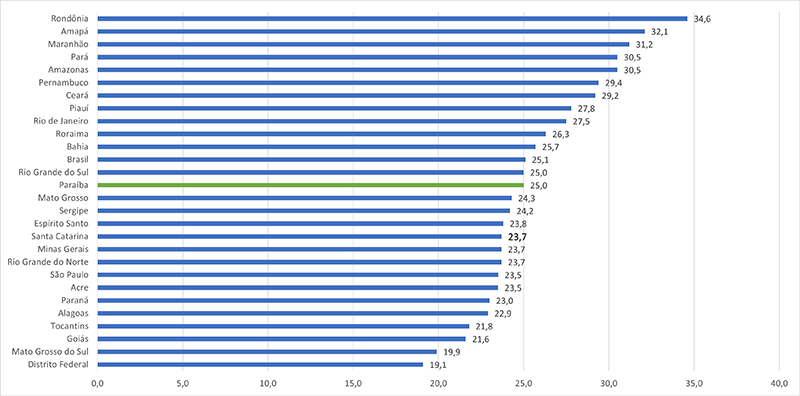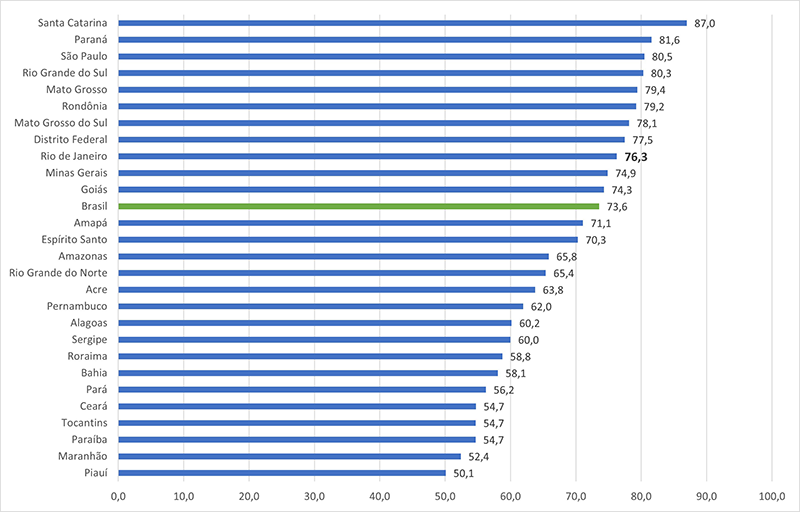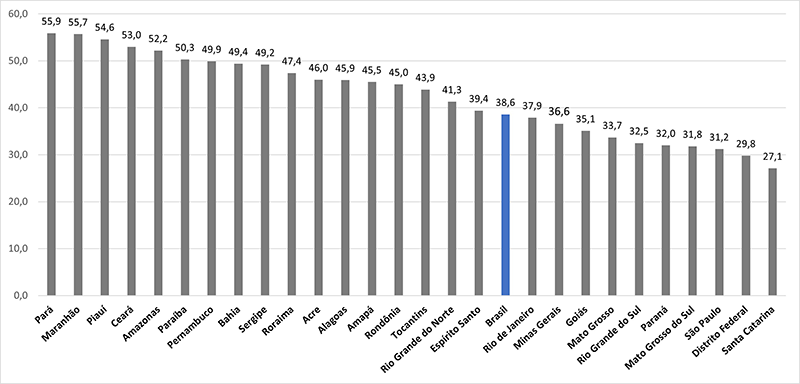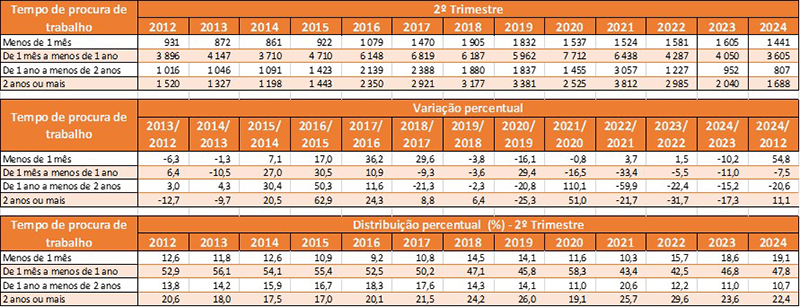Quarterly Continuous PNAD: unemployment falls in 15 of the 27 Federation Units in Q2 2024
August 15, 2024 09h00 AM | Last Updated: August 16, 2024 01h10 AM
The unemployment rate in the country in Q2 2024 reached 6.9%, with a drop of 1.0 percentage points (p.p.) against the first quarter of the year 2024 (7.9%) and of 1.1 p.p. from the same quarter in 2023 (8.0%). Against the previous quarter, the unemployment rate decreased in 15 of the Federation Units (UF), having remained stable in the other 12. Pernambuco (11.5%), Bahia (11.1%) and the Federal District (9.7%) recorded the highest and Santa Catarina (3.2%), Mato Grosso (3.3%) and Rondônia (3.3%), the lowest.
The unemployment rate by sex hit 5.6% for men and 8.6% for women in Q2 2024. As for color or race it was below the national average for white persons (5.5%) and above average for black (8.5%) and brown (7.8%) persons.
Considering people who did not complete high school, the unemployment rate (11.5%) was higher than among other levels of education analyzed. For those who did not complete higher education , the rate reached 7.1%, almost twice as the figure registered for those who had a higher education degree (3.6%).
In Q1 2024, the compound underutilization rate of workforce (percentage of persons unemployed, time-related underemployed and in the potential workforce in relation to extended workforce) was 16.4%. Piauí (33.0%) had the highest rate, followed by Bahia (29.5%) and Alagoas (26.6%). The lowest underutilization rates were those of Santa Catarina (5.8%), Rondônia (7.1%) and Mato Grosso (8.2%).
In the second quarter of 2024, 1.7 million persons had been searching for work for two years and more. This total was reduced by 17.3% from the second quarter of 2023, when 2.0 million persons had been searching for work for two years or more.
The percentage of discouraged persons (compared to the population in the workforce or the discouraged population) in Q1 2024 was 2.9%. Maranhão (11.1%), Alagoas (9.5%) and Piauí (8.8%) had the highest percentages of discouraged persons whereas Santa Catarina (0.3%), Mato Grosso (0.8%), Paraná and Rondônia (0.9%, both) had the lowest.
In Brazil, the percentage of workers with a formal contract in the private sector was 73.6%. The highest percentages of workers with a formal contract were found in Santa Catarina (87.0%), Paraná (81.6%) and São Paulo (80.5%) and the lowest, in Piauí (50.1%) Maranhão (52.4%) and Paraíba (54.7%).
The percentage of self-employed workers in the country was 25.1%. The highest percentages were found in Rondônia (34.6%), Amapá (32.1%) and Maranhão (31.2%) and the lowest, in the Federal District (19.1%), Mato Grosso do Sul (19.9%) and Goiás (21.6%).
The employment-informality rate for Brazil was 38.6% of the employed population. The highest rates were those of Pará (55.9%), Maranhão (55.7%) and Piauí (54.6%) and the lowest, of Santa Catarina (27.1%), Federal District (29.8%) and São Paulo (31.2%).
The average usual real earnings reached R$ 3,214, with an increase from Q1 2023 (R$ 3,158) and from Q2 2023 (R$ 3,037). Among the Major Regions, in the quarter, earnings increased in the South (R$ 3,528) and Northeast (R$ 2,238), having remained statistically stable in the other ones. In the annual comparison, there were increases in the South, Northeast and Southeast (R$ 3,627) with stability in the North (R$ 2,508) and Central West (R$ 3,641).
Against Q1 2024, the unemployment rate dropped in 15 of the 27 Federation Units and was stable in the remaining ones. The highest rates were those of Pernambuco (11.5%), Bahia (11.1%) and the Federal District (9.7%), and the lowest, of Santa Catarina (3.2%), Mato Grosso (3.3%) and Rondônia (3.3%).
Unemployment rate, by FU, against the previous quarter (%) – Q2 2024
| FU | Q1 2024 | Q2 2024 | status |
|---|---|---|---|
| Pernambuco | 12,4 | 11,5 | → |
| Federal District | 9,5 | 9,7 | → |
| Rio Grande do Norte | 9,6 | 9,1 | → |
| Sergipe | 10,0 | 9,1 | → |
| Amapá | 10,9 | 9,0 | → |
| Paraíba | 9,9 | 8,6 | → |
| Roraima | 7,6 | 7,1 | → |
| Rio Grande do Sul | 5,8 | 5,9 | → |
| Paraná | 4,8 | 4,4 | → |
| Mato Grosso do Sul | 5,0 | 3,8 | → |
| Rondônia | 3,7 | 3,3 | → |
| Mato Grosso | 3,7 | 3,3 | → |
| Santa Catarina | 3,8 | 3,2 | ↓ |
| Rio de Janeiro | 10,3 | 9,6 | ↓ |
| Goiás | 6,1 | 5,2 | ↓ |
| Brasil | 7,9 | 6,9 | ↓ |
| Minas Gerais | 6,3 | 5,3 | ↓ |
| São Paulo | 7,4 | 6,4 | ↓ |
| Pará | 8,5 | 7,4 | ↓ |
| Ceará | 8,6 | 7,5 | ↓ |
| Maranhão | 8,4 | 7,3 | ↓ |
| Espírito Santo | 5,9 | 4,5 | ↓ |
| Acre | 8,9 | 7,2 | ↓ |
| Tocantins | 6,0 | 4,3 | ↓ |
| Alagoas | 9,9 | 8,1 | ↓ |
| Amazonas | 9,8 | 7,9 | ↓ |
| Piauí | 10,0 | 7,6 | ↓ |
| Bahia | 14,0 | 11,1 | ↓ |
Piauí has the highest underutilization rate (33.0%) and Santa Catarina, the lowest (5.8%)
In the second quarter of 2024, the compound underutilization rate of the workforce was 16.4%. Piauí (33.0%) had the highest rate, followed by Bahia (29.5%) and Alagoas (26.6%). The lowest rates were found in Santa Catarina (5.8%), Rondônia (7.1%) and Mato Grosso (8.2%).
Compound underutilization rate of the workforce by state (%) - Q2 2024

Rondônia has the highest percentage of self-employed persons (34.6%) and DF has the lowest (19.1%)
The percentage of the self-employed population in the country was 25.1%. The highest percentages were found in Rondônia (34.6%), Amapá (32.1%) and Maranhão (31.2%) and the lowest in the Federal District (19.1%), Mato Grosso do Sul (19.9%) and Goiás (21.6%).
Percentage of self-employed persons, by state (%) - Q2 2024

Lowest percentage of workers with formal contracts is in Piauí (50.1%) and the highest, in Santa Catarina (87.0%)
In the second quarter of 2024, 73.6% of persons employed in the private sector in the country had a formal contract. Among the Federation Units, the highest percentages of employees with a formal contract in the private sector were found in Santa Catarina (87.0%), Paraná (81.6%) and São Paulo (80.5%) and the lowest, in Piauí (50.1%), Maranhão (52.4%) and Paraíba (54.7%).
Percentage of employed persons with a formal contract among private sector employees, by Federation Units (%) -
Q2 2024

Compared to the previous quarter, earnings increased only in the South and Northeast
In comparison with the 1st quarter of 2024, among the Major Regions, real average earnings of the employed population increased in the South (R$3,528) and the Northeast (R$2,238), and remained statistically stable in the other regions. In the annual comparison, there were increases in the South, Northeast and Southeast (R$3,627), with stability in the North (R$2,508) and Central-West (R$3,641).
Real average earnings from all jobs was estimated at R$322.6 billion, up on both the previous quarter (R$311.8 billion) and the second quarter of 2023 (R$295.4 billion).
The Southeast Region had the highest real wage bill (R$165.0 billion) in the 2nd quarter of 2024. In comparison with the 1st quarter of 2024, the wage bill increased in all the Major Regions, except for the Central West, which showed stability.
Pará has the highest informality rate (55.9%) and Santa Catarina, the lowest (27.1%)
The employment informality rate for Brazil was 38.6% of the employed population. The highest rates were those of Pará (55.9%), Maranhão (55.7%) and Piauí (54.6%) and the lowest in Santa Catarina (27.1%), the Federal District (29.8%) and São Paulo (31.2%).
To calculate the proxy for informality rate of the employed population we consider employed persons in the private sector without a formal contract, domestic workers without a formal contract, employers without a CNPJ registration, self-employed workers without a CNPJ registration and auxiliary family workers.
Employment informality rate of the employed population, by state (%) - Q2 2024

Unemployment drops by more than 10% in all ranges of period of search
In the second quarter of 2024, the number of unemployed persons in the four ranges of period of job search analyzed by the continuous PNAD dropped by more than 10% against the same quarter of the previous year, as the following table illustrates.
In addition, the number of people searching for a job for two years or more dropped to 1.7 million, reaching the lowest number of unemployed persons in this range for a second quarter since 2015. Although it dropped 17.3% against the second quarter of 2023, this total is still 11.1% higher than the total of persons searching for a job for two years or more in the second quarter of 2012, the first year of the PNAD Continuous time series.


